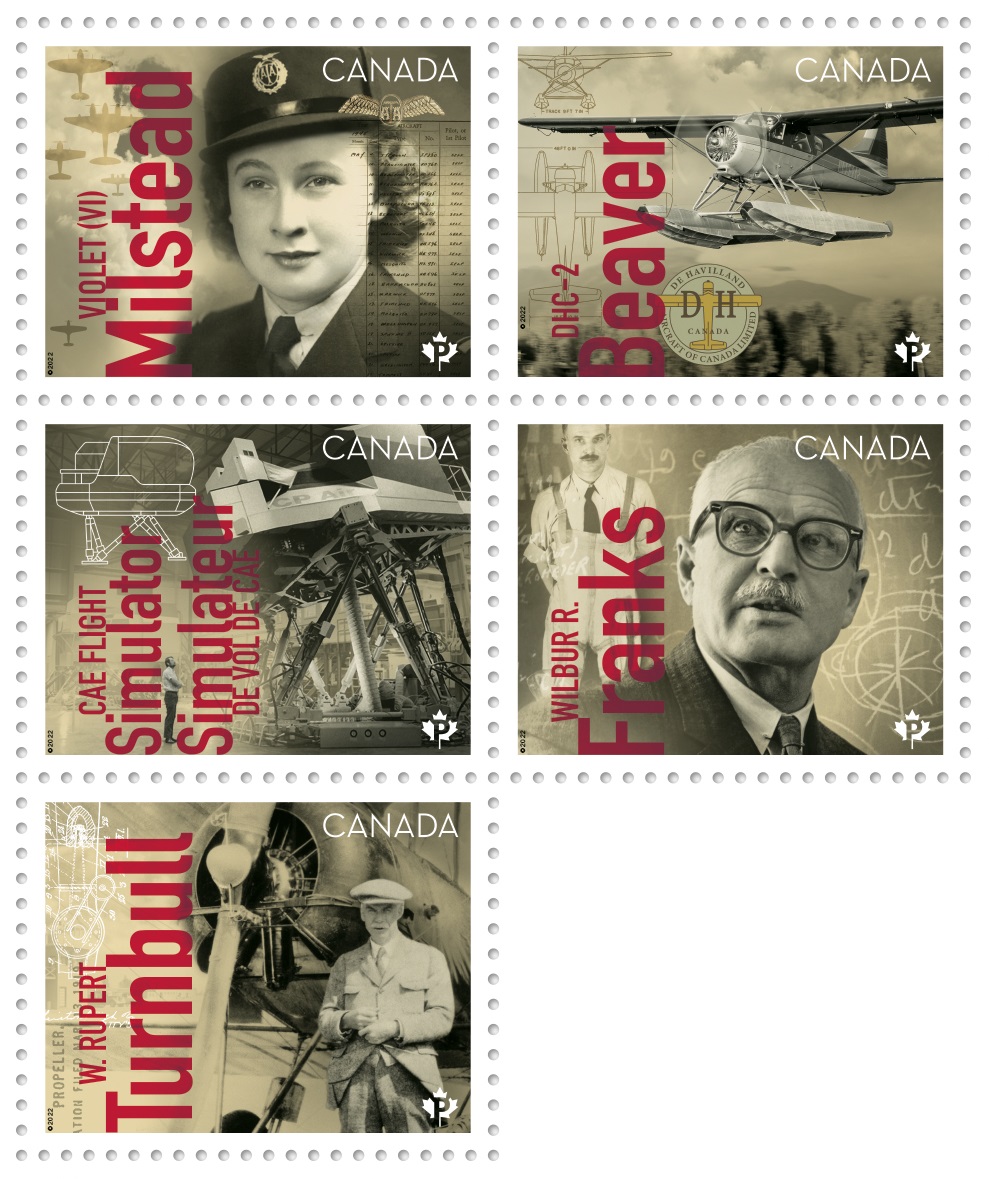October 13, 2022
Posted in News Releases
Canadians in Flight stamps celebrate leadership in aviation and aeronautics technology, innovation
Five-stamp set commemorates groundbreaking female pilot, legendary bush plane and three innovators who changed aviation
October 13, 2022
Posted in News Releases

OTTAWA – Canada Post released the second instalment of its Canadians in Flight stamps today, an issue that celebrates the people, planes and technology that have allowed Canada’s reputation for innovation to soar.
Developed with the support of Canada’s Aviation Hall of Fame, the Canada Aviation and Space Museum, as well as the Ottawa chapter of the Canadian Aviation Historical Society, this edition of Canadians in Flight honours these achievements:
- Violet (Vi) Milstead (1919-2014). One of Canada’s first female bush pilots, Toronto-born Vi Milstead instructed at Toronto’s Barker Field before signing up with Britain’s Air Transport Auxiliary during the Second World War. The civilian organization ferried military aircraft between factories and front-line squadrons. Over 28 months, Milstead logged more than 600 hours in 47 types of aircraft, including massive, multi-engine bombers. Following the war, she moved to Sudbury, Ont., where she flew as a bush pilot and also instructed.
- The de Havilland Canada DHC-2 Beaver. The Beaver is considered the best bush plane ever built and was named one of Canada’s top 10 engineering achievements of the 20th The all-metal plane’s short takeoff and landing capability – along with its ability to be fitted with wheels, floats or skis – made the Beaver ideal for accessing and connecting remote areas of the country.
- Kenneth Patrick (1915-2002) and the CAE flight simulator. New Brunswick’s Kenneth Patrick, a former Royal Canadian Air Force officer, introduced simulator technology to Canada through CAE Inc. (then Canadian Aviation Electronics Ltd.), the company he founded in 1947. By the 1980s, CAE had developed a simulator so realistic it was no longer necessary for all flight training to be completed on actual aircraft. Today, air travel is the safest mode of transportation in part because commercial pilots train in simulators – most produced by CAE Inc.
- Wallace Rupert Turnbull (1870-1954) and the variable pitch propeller. This Saint John, N.B., native was a pioneering aeronautical engineer who developed the variable pitch propeller. The device allowed pilots to adjust the pitch, or angle, of propeller blades in flight as easily as one would change gears in a manual car. This improved the aircraft’s efficiency.
- Wilbur R. Franks (1901-86) and the G-suit. Franks, born in Weston, Ont., developed the world’s first anti-gravity suit used in combat, during the Second World War. The rubber suit, which he personally tested and was also known as the Franks Flying Suit, was lined with water-filled pockets that created enough hydrostatic pressure to counter strong gravitational (G) forces.
These global advances provided the foundation for ongoing improvements in aviation and remain an important part of Canadian history.
The stamp issue, designed by Ivan Novotny of TaylorISprules Corporation and printed by Lowe-Martin, is available in a booklet of 10 PermanentTM domestic rate stamps (two of each design) and a gummed mini-pane of five. A limited number of framed panes and five Official First Day Covers are also available as a set or separately.
The stamps and collectibles are available for pre-sale today at canadapost.ca and at postal outlets across Canada on the day of issue, Monday, October 17. For images and more information on these and other products:
- External folder with high-resolution images (click here).
- Details magazine (click here and this external folder).
- Article on the Canada Post magazine (click here).
- Social media platforms – Facebook, Instagram and Twitter.
The first five stamps in the series can be found in this 2019 edition of Details.
- 30 -
For more information:
Media Relations
613-734-8888
media@canadapost.ca
™Trademark of Canada Post Corporation